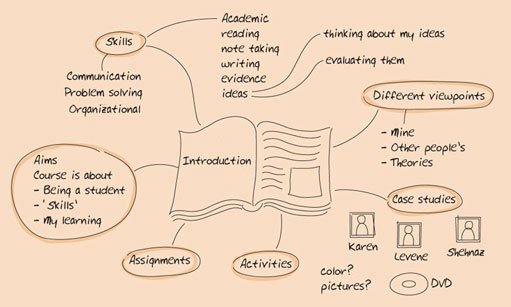2 Using mind maps
One technique that many people find helpful is to draw a mind map that allows you to explore how all your different ideas could be connected.
Mind mapping was invented and developed by Tony Buzan, an author who has explored ways in which people think and learn. The technique helps open your mind to a broad range of ideas, and record these in a flexible format that can be easily altered and developed. So, as well as organising your thoughts and essay plans, mind mapping can help you to think more creatively and to come up with new ways of looking at things.
A mind map can be produced for any subject or topic. A good way of creating a mind map is to start with a large sheet of paper and coloured pens or pencils. Mind maps usually begin in the middle of the paper with a word, phrase, picture or symbol that represents the topic being explored.
The next stage is to let your mind wander as freely as possible around the topic. Think of some key words or phrases (there is no right or wrong here), then write them near to the central image or words. Finally, connect each of them to the centre with lines. This is the beginning of your mind map.
Keep adding lines and words (and pictures, if you like), linking them to each of the words or phrases that triggered them – so that your map becomes a network of words and lines.
Mind maps are often very personal – they are, after all, maps of your mind. They can be as elaborate or as simple as you wish – whatever you find helpful. Some people like to add a lot of detail, including colour, pictures, page references and examples, while others prefer a simple plan, concentrating on key points.
The figure below is a simple mind map that a student created for an earlier version of this course, reflecting on what they had learned.
Now you have a go.
Activity 2 Looking back and creating a mind map
Look back through this course and summarise some of the key things that you have studied so far, using a mind map.
- For this mind map, the central theme is ‘succeed with learning’, so put that in your central bubble.
- Then go back through the course picking out the main ideas and the key points that we have covered. You can approach this how you like, but one way is to skim read the pages of the course. Look back at the headings in each week – and use some of these as key words. Then look over your own notes to see if certain aspects of the course were particularly relevant to you.
- Now draw lines from the central bubble outwards for each of the key things you feel you have learned, and write these down. You can draw more lines and bubbles as you think of more related things that you have learned.
Discussion
You may want to add some comments about how you felt, or other thoughts and ideas that were triggered.

